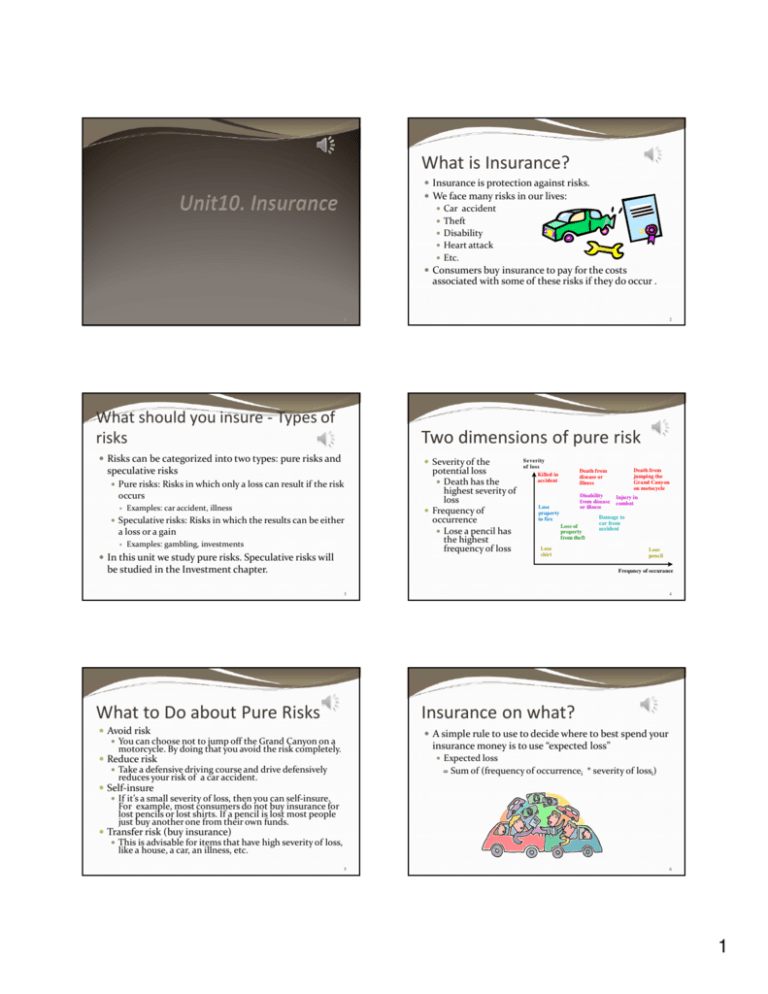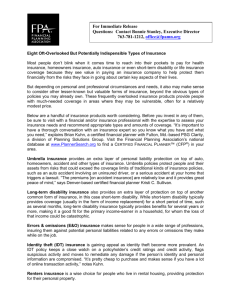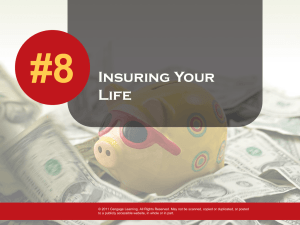What is Insurance? Two dimensions of pure risk What to Do about
advertisement

What is Insurance? Insurance is protection against risks. We face many risks in our lives: Car accident Theft Disability Heart attack Etc. Consumers buy insurance to pay for the costs associated with some of these risks if they do occur . 1 What should you insure - Types of risks Two dimensions of pure risk Risks can be categorized into two types: pure risks and Severity of the speculative risks Pure risks: Risks in which only a loss can result if the risk occurs Examples: car accident, illness Speculative risks: Risks in which the results can be either a loss or a gain 2 Examples: gambling, investments In this unit we study pure risks. Speculative risks will potential loss Death has the highest severity of loss Frequency of occurrence Lose a pencil has the highest frequency of loss Severity of loss Killed in accident Death from jumping the Grand Canyon on motocycle Death from disease or illness Disability from disease or illness Lose property in fire Loss of property from theft Injury in combat Damage to car from accident Lose shirt be studied in the Investment chapter. Lose pencil Frequncy of occurance 3 What to Do about Pure Risks 4 Insurance on what? Avoid risk You can choose not to jump off the Grand Canyon on a motorcycle. By doing that you avoid the risk completely. Reduce risk Take a defensive driving course and drive defensively reduces your risk of a car accident. Self-insure If it’s a small severity of loss, then you can self-insure. For example, most consumers do not buy insurance for lost pencils or lost shirts. If a pencil is lost most people just buy another one from their own funds. Transfer risk (buy insurance) This is advisable for items that have high severity of loss, like a house, a car, an illness, etc. A simple rule to use to decide where to best spend your insurance money is to use “expected loss” Expected loss = Sum of (frequency of occurrencei * severity of lossi) 5 6 1 An example of expected loss – car accident possibilities for six months Frequency of occurrence Severity of loss Expected loss $50 Light auto damage 10% $500 Medium auto damage 5% $1,500 $75 Light personal injury 5% $2,000 $100 Heavy auto damage 1% $5,000 $50 Medium personal injury 1% $5,000 Total expected loss = In the table on previous slide, for this person, we are estimating that the person has a 10% chance of getting into a small car accident that can cause a damage of about $500. In this case usually there is no personal injury. A medium auto damage is probably coupled with a light personal injury, with a 5% probability and an average of $1,500 for auto damage and $2,000 for personal injury. A heavy auto damage is usually coupled with a medium personal injury, with a 1% probability and an average of $5,000 of auto damage and $5,000 of personal injury. Expected Loss = (10%*500)+(5%*1500)+5%*2000+1%*5000+1%*5000 =325 Note this is just a simplified example. $50 $325 7 The concept of diminishing marginal utility again 8 Util, and Diminishing marginal utility in loss situations Remember in Unit 1 we talked about diminishing marginal The expected loss usually is computed in “consumer value or diminishing marginal utility of consumption? value of loss” – or “util” – a measure of utility, instead of just dollar values. The rule of diminishing marginal value in loss situations implies that The is, the value of the first hamburger to a hungry consumer is a lot more than the value of the fifth hamburger. The same concept applies to income. The value of the first $10,000 of income is a lot more than the value of the fifth $10,000 of income. Why? The last $1000 loss cause more suffering than the first An increase of income from $0 to $10,000 makes a world of difference – from not being able to eat to have something to survive. An increase from $50,000 of income to $60,000 of income is nice, but not nearly as life-changing as an increase from $0 to $10,000. $1000 loss. So the last $1000 loss may have 5000 utils, whereas the first $1000 loss may only have 1000 utils. 9 How does util affect insurance priority? 10 What kinds of insurance to buy? Buy insurance on those pure risks that have the Large but infrequent losses will be more important to insure compared to small but frequent losses, because large losses have more disastrous effect on the consumer, and thus cause more loss of utils. highest expected loss in utils. Suggested priority for insuring pure risks Car accident vs. disability – expected loss in dollar values: Expected loss of car accident = 10%*5000=500 Expected loss of disability =0.5%*50000=250 But measured in utils, it might be: Expected loss of car accident =10%*5000=500 Expected loss of disability=0.5%*130000=650 So measured in value to consumers, disability insurance is more important than car insurance in the above example. 11 Death (if have dependents) - Life insurance Disability - Disability insurance Medical costs – Health insurance Liability – Both Home and Auto have liability coverage Property damage to home (if homeowner) Property damage to possessions Property damage to car 12 2 What Determines Insurance Prices? Why do some people do very risky things while others don’t? People may think they have different probabilities of loss. This can be factually true or false. For example, a good driver has a lower probability of getting into an accident than a bad driver. So that is factual. But a bad driver might think he is a good driver and falsely believes he has a lower probability. People may derive different level of benefits from the same activity. For some, jumping off the Grand Canyon on a motorcycle is no fun at all. But for others, it can be the fun of their lifetime Premium= expected loss + service charge Note the textbook use the term expected benefits instead of expected loss. It ‘s the same concept from different perspectives: If no insurance then it’s an expected loss for the consumer. If insurance, than the payment becomes a benefit. In the previous example, the premium can be $325+$50=$375 In any case, if the expected benefits are more than the expected loss then people will take that risk. In real life situations companies will not assess your risk level on an individual basis. They will put you in a group and assess the group risk situation. 13 Example of insurance premium 14 A further note on insurance premium Suppose you are buying health insurance from the Sometimes insurance quotes for multiple years university. There are 20,000 students in the group. The health insurance company will assess, from past experiences, the risk of group as follows for the year: are given. For example, you can buy life insurance (insurance that pays your beneficiary in case of your death) that covers 20 years. In those cases the insurance company will assess your risk of death for the next 20 years, and compute the PV of all these future benefits. So in those cases PV again applies. See textbook for a good example on a 5-year health insurance premium calculation. 5% probability of large claims of 20,000 each. 10% probability of medium claims of $2,000 each . 50% probability of small claims of $100 each . Service charge of $200 is added on top of that. Premium=5%*20000+10%*2000+50%*100+200 =1000+200+50+200=1450 Note real situations are a lot more complicated. 15 16 Important factors affecting insurance prices Does interest rate play a role? One more factor we have not covered is interest rate. When companies collect premiums, they do not pay out all at once, so money is invested for future payouts. As such, the higher the interest rate, the less premium companies need to charge in order to payout all the claims. The description on Page 382 of the insurance liability crisis of 1985-1986 gives a very good example of the role interest rate plays in determining insurance premiums. 17 From the premium formula we can learn the following: Probability of claim up --> premiums up Uncertainty about future --> probability up --> premiums up Size of claim up --> premiums up Interest rate up ->premiums down 18 3 Deductibles, Co-insurance and Cap Coinsurance Deductibles The amount you pay out of your pocket on a clam before the insurance company pays anything. Benefits of deductibles: lower premiums. Why? Incentive to avoid the risk – addressing the issue of moral hazard The percentage of the loss that the insured must pay, after the deductible amount. In health insurance this coinsurance rate can be different for different types of medical services. Cap The insured will only pay up to a certain amount. In health insurance there usually is a cap on out-of- Moral hazard refers to the possibility that the transfer of risk (such as through insurance so the risk is transferred to the insurance company) changes people’s behavior. People may be less careful in driving, more likely to visit the physician for trivial things, etc. pocket payment per year so the insured will not pay, for example, over $5000 per year. Lower administrative costs – no need to process small claims 19 An example of deductibles, coinsurance, and cap 20 If the insurance plan has a co-payment cap of $800 You pay You suffer a $10,000 loss Insurance plan: $500 deductible and 10% coinsurance rate with no cap Deductible = 500 Co-payment = min [800, 10%(10,000=500)] = min [800, 950] = 800 Your total payment = 500+800=1,300. Insurance company pays 10,000-1,300=8,700 You pay Deductible = 500 Co-payment = 10% * (10,000 - 500) = 950 Your total payment = 1,450 Insurance company pays 10,000 - 1,450 = 8,550 21 22 Life Insurance A note on different types of insurance Insure against your death Needed when you have financial dependents, such as High deductible policies make economic sense. Reason: You reduce the premium cost per dollar of children. To make sure they have enough financial resource to live on in the unfortunate event of your death. The older you are, the more expensive the premiums are because the risk of your death increases when you get older If you smoke, drink, have chronicle illness like diabetes, your premiums are higher There are many life insurance products out there, many involving an investment component. It is usually recommended that you stick with insurance only without the investment component. insurance, thereby can afford more total coverage to insure catastrophic losses. One researcher suggests: Choose a deducible equal to 3% of your net worth. 23 24 4 Disability Insurance Health Insurance A main concern is how the policy defines “disability”. Affordability – Medical costs increase a lot faster than There are three categories of definitions: general inflation. Why? Inability to do your current job Inability to do any job for which you are reasonably Mostly because of better care – new treatments, new tests, new drugs, etc. all cost more money If you cannot afford to pay a lot for insurance trained. Inability to do any job. premiums, try to increase your deductibles and coinsurance payments. The important thing is to have enough coverage to cover catastrophic events. Note that prescription drug benefits and dental benefits are usually separate from the main coverage. The first is most favorable to consumers. Some companies use a combination of the definitions, such as for the first three years use the first definition, then switch to the second. 25 Homeowner’s Insurance 26 Automobile Insurance Covers damages to your home and its contents, and covers Coverage that pays for damage to others: personal damages (liability) to anyone injured at your home. Pay attention to the types of risk covered In Utah you might want to consider earthquake insurance Rule of thumb is to insure about 80% of the replacement value of your house. Replacement value = if you need to rebuild the same house and buy all the stuff new in the house, how much will it cost? Usually it is more than the current value because everything will have to be new. Bodily injury – pays for injury /death of other people Property damage – pays for damage to other people’s car or house (if you hit one) The limits usually expressed as something like 100/300/500, meaning that a maximum of $100,000 will be paid for bodily injury to any single person, a maximum of $300,000 will be paid for bodily injury to all persons, and a maximum of $500,000 will be paid for all property damages. 27 28 Coverage that pays money to you for your loss Collision – pays for damage to your car in accidents you caused. The more expensive your car, the higher the premium on collision. Comprehensive – pays for damage to your car resulting from non-accidents Windshield cracks caused by little gravels on the road Medical insurance – pays for medical costs for you if you cause the accident. Uninsured and underinsured motorists – pays for your damage if the party that caused your accident does not have enough coverage 29 5




